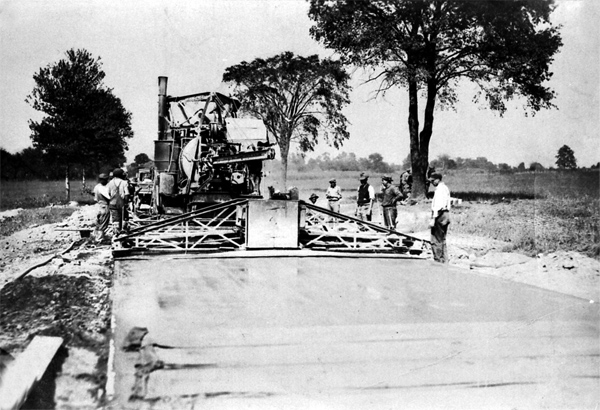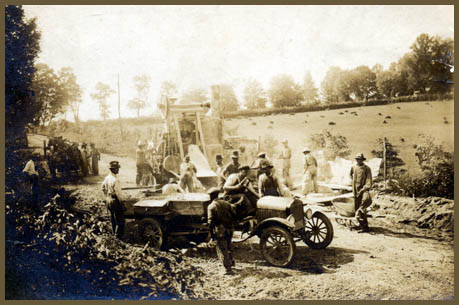

  |
|

|
Name: Paving Route 20 to Charlottesville Date: 1921 Image Number: Roll4Neg3A Comments: The road (Route 20) between Scottsville and Charlottesville was known as the 'Road of the Presidents' in the 1800's because Presidents Jefferson, Madison, and Monroe often traveled over it. In those years, the trip between the two towns was arduous and bone-jarring as the macadam used on the road was a thin, poor tar mixture that soon broke up under heavy wagon traffic. Then rains would further plague travelers as they slid around on the rutted, muddy road. Until 1884, all male citizens in the county between the ages of sixteen and sixty (ministers of the gospel excepted) were required to work on roads near their homes for several days each year. This system resulted in haphazard road maintenance, and many travelers might have agreed with Thomas Jefferson, who, watching a balloon ascent in Philadelphia in 1793, wrote to his daughter, "I wish for one sincerely, as instead of 10 days, I should be within 5 hours of home." The two photos on this page show the paving of Route 20 with concrete by Maloney Paving Company in 1921, the first road in the county to be paved with state funds. By 1922, there were only 73 miles of paved roads in Albemarle County. Due to the improved travel conditions on Route 20 and increased availability of automobiles, Scottsville residents became more oriented toward Charlottesville as a marketplace. Before this time, following first the James River and Kanawha Canal and then the railroad in 1881, Scottsville thought of Richmond and Lynchburg as commercial centers as it was not connected to Charlottesville even by train. Until 1956, a passenger train from Richmond to Lynchburg (and beyond) stopped daily in Scottsville. A relic of these days is the continued routing of Scottsville-Charlottesville mail through Lynchburg. Following is more research info on the 'Paving of Route 20' provided by Evelyn Edson and Ruth Klippstein in November 2020: Traveling to Scottsville once meant the river via batteau, then the canal. The railroad came through Scottsville in the 1880's, linking the town to Lynchburg on the western end and Richmond on the east. Then in the early twentieth century, a new form of transportation appeared: the motor car. This newfangled invention was regarded with horror at first. Noisy, dangerous, and too fast, it had the tendency to spook the horses. The roads leading in and out of Scottsville were muddy, potholed, and not car-friendly. The main route from Scottsville to Charlottesville was Route 20, which is mentioned in road orders dating 1746, though not by its current number that it did not receive until 1933. Scottsville Road or "Court House Road" followed a meandering course along the west side of Carter's Mountain. For a long time, the main obstacle was the Hardware River. "Secretary's Ford" and then a bridge (Carter's Bridge) took one across. The road orders for Virginia show repeated requests for replacing the bridge that had just been swept away by flood (again). The latest version of Carter's Bridge looks quite sturdy. Will it stand up to the occasional rampages of the Hardware River? At the dawn of the auto age, Route 20 was tarred and coated with a thin layer of gravel. In 1922 with great fanfare, it received a modern road surface of concrete with smoother layers of asphalt. Older folk will remember bumping along the tarry joints of these concrete highways, now replaced with smoother layers of asphalt. As passenger rail disappeareed and automobiles proliferated, Scottsville became increasingly tied to Charlottesville. By 1947, Scottsville Road was completely paved, and a trip to Charlottesville was a matter of half an hour, not an hour and a half. As part of his tireless campaign to boost the reputation and riches of Scottsville, the late Raymon Thacker urged the designation of Route 20 as "The Constitution Route." Going from Orange to Dillwyn, it took one (more or less) past the residences of three former presidents: Madison, Jefferson, and Monroe. It is so marked on the official state map of Virginia. Copyright © 2020 by Scottsville Museum |

|
|
|
Museum
Archive
Business
Cemeteries
Church
Events
Floods
For Kids
Homes
Portraits
Postcards
School
Transportation
Civil War WWII Esmont Search Policy |
||||
|
Scottsville Museum · 290 Main Street · Scottsville, Virginia 24590 · 434-286-2247 www.avenue.org/smuseum · info@scottsvillemuseum.com Copyright © 2020 by Scottsville Museum |
||||